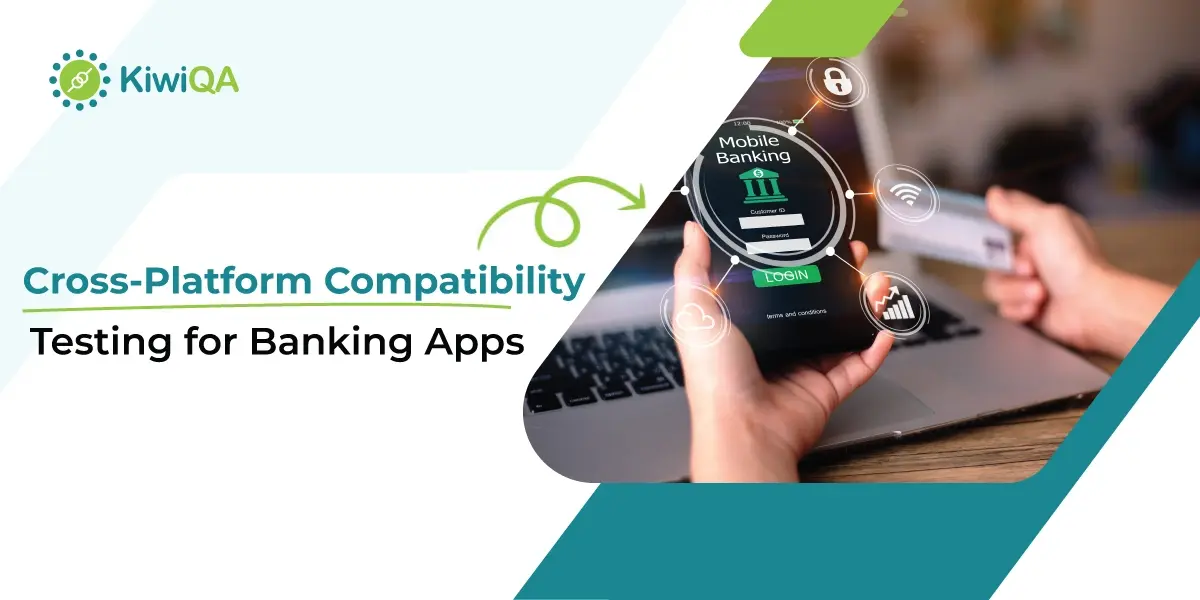Cross-Platform Compatibility Testing For Banking Apps

 KiwiQA
KiwiQATable of Contents
Banking is the most challenging & highly complicated industry. Since banking is a highly regulated industry, e-banking apps must be designed & developed in compliance with security and privacy; for any financial institution, credibility is the biggest term, and the industry can’t expect any glitches because even a minor mistake can impact the user experience. This is when cross-platform compatibility testing is required to tackle the challenges.
Do you know what is what is cross-platform compatibility? Cross-platform end-to-end compatibility testing is a need for advanced software development. The testing ensures the application is operating across various platforms and satisfies the user requirements. This guide will help you to understand the fundamentals of cross-platform end-to-end testing.
Whether it’s Firefox, Edge, Chrome, or Safari, your software is required to work equally across every platform. Does your app perform equally with different browser versions? Cross-platform testing refers to software applications that can function effectively across different operating systems, device types, and browsers. Ensuring a consistent user experience across various software development environments is imperative. This is all you should know about what is cross-platform compatibility.
Cross-platform compatibility testing is the procedure of quality assurance in web development. This testing involves ensuring a web application or website is functioning on different web browsers and versions. Multiple companies develop web browsers, so they have distinct rendering engines that might interpret CSS, JavaScript code, and HTML differently. It can further lead to errors in how a website behaves and looks and cause problems for users who access the web app through different browsers.
We all use banking apps to make transactions in our day-to-day lives and expect an error-free user experience. Cross-platform app testing is important for banking applications to facilitate a positive user experience.
To guarantee the functionality, performance, and quality of financial or banking apps, application security testing for fintech is required. Through fintech security testing, you can address and fix any errors & vulnerabilities that hamper security. This testing is necessary to deliver a secure, flawless, easy-to-use, and smoothly operated application. The financial organization should deliver a user-friendly, secure, and dependable application that meets with customer experience.
Cross-platform mobile app testing is non-functional testing that allows you to check whether the application works on the necessary devices and browsers or not. The testing is done to check whether it is intended to access on-
The mobile apps are tested to determine whether it is accessible on cross-platform browsers: Chrome, Safari, Edge, Firefox, and other operating systems, for example, macOS, iOS Android, and Windows.
The application is also tested on platforms/devices like tablets, smartphones, laptops, and desktops.
The application should also be compatible with assistive technologies, for example, screen radars.
As the banking app market is growing, people have increased trust in these apps. Based on the recent report it is found that 6 out of every 10 mobile users prefer to use banking applications on their phone to manage accounts.
Another market report shows that 90% of people use mobile banking apps to track their account balances, whereas 79% of people use mobile banking apps to track their transactions.
To make your banking app compatible and to be part of this race, you need to tackle the challenges caused due to platform diversity. The security of mobile banking applications is the foremost concern. These apps contain the most sensitive information of data, so there is always a fear of data breaches, malware attacks, etc. To maintain the legitimacy of your business, it is necessary to implement cross-platform compatibility testing.
Here are some major cross-platform compatibility testing methodologies which are mostly used-
Manual testing is most effective when applied to compact banking software systems. The QA team can perform cross-browser testing manually to track the changes in the functionality of various web clients. It requires human interactions to carry out every aspect of testing. To test the website manually, first, you should have installed operating systems and various browsers on mobile devices and desktops. After that, we manually perform this similar test in every environment. Performing manual testing is time-consuming and draining. For a variety of scenarios, manual testing is impractical.
As we already mentioned, it is practically impossible to cover the cross-platform compatibility testing manually. So, most financial organizations prefer automated testing. This testing aims to ensure that the application can uniformly perform with all devices. Using advanced automation tools, the compatibility testing can be done in minutes. With the advanced automation tools, testing can be performed on real-time devices with different configurations, browsers, and regulations. The automation tool supports functional testing, visual testing, and regression testing with CI/CD integration.
Cloud-based cross-platform testing involves testing banking applications on cloud platforms using cloud-based tools. In this testing, the testing environment will be set up on the cloud platform, and the testing will be done from there. It allows testers to access the test environments from any corner if they have strong internet connectivity. Cloud-based testing is faster testing & it is cost-effective. You only have to pay for what you have used.
Evaluating the security, reliability, and usability of banking applications requires a carefully planned approach. It is recommended to create a comprehensive strategy for core banking application testing system which covers every aspect of the application. If you don’t want to meet with any unforeseen issues in the future, then follow the below cross-platform compatibility testing cases-
User authentication is mostly required for the registration and login page. User authentication is necessary to avoid unauthorized access. Here are some most popular login and authentication test cases you need to consider-
Testing login functionality with valid credentials
The account balance is the repository for all the crucial information about the customer’s investment and financial status. So, it is necessary to prioritize this section during the testing phase. Here, we categorize the list of test scenarios to check banking app compatibility so that you can get started now-
The banking industry is highly risky, and that’s why the testing should be done in the various layers. To meet the user’s expectations and security compliance, follow the testing cases below.
People use banking applications to complete multiple payments like bill payments and grocery payments. To ensure your banking app meets user expectations, carry out the following strategies-
Securing banking applications is crucial as they house the highly confidential data of countless users. Therefore, here are the essential steps to guarantee the safeguarding of your banking app.
By following the above strategies of testing scenarios, you can make your banking application flawless.
You can access multiple tools which will help you to test the web applications efficiently. Check out some popular names you can use to tackle cross-platform compatibility issues-
Appium is a freely available resource that simplifies the testing of hybrid, native, and mobile banking apps across various platforms. Appium supports Android platforms and iOS, which makes it suitable for automating tests on real devices.
Selenium stands out as the foremost open-source solution for enabling cross-platform testing of web applications. This tool is used for multiple programming languages, which include C, Python, and Java. Well, it can also be achieved through TestNG, Junit.
It is a cross-browser cloud-based testing platform that allows testing of the website & banking app on a huge range of operating systems and browsers. It offers accessibility to the real browser for manual testing and supports automated testing with Appium & Selenium.
Sauce Labs is a cloud-based testing company that offers a comprehensive range of devices and browsers for mobile application and web testing. This tool is compatible with both automated and manual testing, and it seamlessly integrates with well-known testing frameworks such as Selenium and Appium.
Whether you are a developer or quality assurance engineer, we will help you improve the banking application quality with effective testing procedures. In between the testing procedure, you might meet with some common challenges, which are mentioned below-
Device fragmentation or cross-device testing is used for defining multiple devices available today, each having varied display size, resolution, and hardware compatibility. When developers face any issues, it’s their responsibility to ensure their program runs correctly on multiple tools.
Every operating system has different characteristics that encompass a diverse set of APIs, designing principles, and programming languages. Maintaining platform compatibility can be tough, and that’s why there should be a bridge maintained between the multiple operating systems by utilizing cross-platform frameworks.
The mobile cross-platform framework delivers responsive design equipment to deal with the issue and assure user experience across various screen sizes, making a banking application seamlessly run on different devices.
Multiple browsers are used by individuals worldwide. Every browser has multiple versions. A website that wants to gain a significant use base should be compatible across multiple browsers & versions. Cross-browser testing is a major part of web development that ensures the website is perfectly accessible to every user.
To get rid of these challenges, the testing team should take the necessary approach. Check the best practices for cross-platform testing banking applications.
By adhering to the following best practices, the testing team and web developers can effectively tackle the above challenges. By following the below practices you can make your banking application reliable and user-friendly.
Every banking app is unique in terms of specifications or features as they are developed to deal with real-world problems. That’s why it’s advisable to commence the testing phase a bit ahead of schedule. Testing earlier ensures that the developed application meets all the end-user requirements. Develop a test plan based on the application requirements.
The right way to avoid the challenges is to opt for the browser stack cloud infrastructure. This tool gives access to real devices for manual and automated testing. Multiple testers and the QA team interactively test on the huge range of Android & iOS devices on the cloud using this tool.
Maintaining a comprehensive test Matrix is also necessary when following cross-platform compatibility testing. Get familiarized with the tools available, which allow you to inspect the elements, stimulate the different browser environments, and debug JavaScript. In this way, you can make the process easier.
Give high priority to the critical scenarios and testing on the most used web browsers like Google Chrome, Apple Safari, Mozilla Firefox, Microsoft Edge, etc. These browsers have the highest user base and are the most used. Test the application on different scenarios to make it reliable and user-friendly.
To expedite the project, consider teaming up and working together to finish it swiftly. Through regular discussions with the team, you can maintain the test accessibility tra, check the issues, and solve them one by one quickly. In addition to everything else, make sure to keep yourself updated on the most recent advancements. Review and update the testing procedure to ensure cross-browser compatibility.
Testing cross-browser compatibility is the crucial phase of web development. By following the necessary practices and the above-discussed guide, you can ensure that your online banking app offers a delightful user experience by consistently running on different web browsers.
By using the combination of browser developer tools and cloud-based platforms for testing, you can test your banking application to deliver a consistent user experience. Finance app testing is a wide and complex term, and that’s why it should be done carefully by top-notch industry experts.
Join the like-minded community & get the latest updates and insights on software testing technological transformation around the globe. Don't miss out.
